
Manta rays are large rays belonging to the genus Mobula. The larger species, M. birostris, reaches 7 m (23 ft) in width, while the smaller, M. alfredi, reaches 5.5 m (18 ft). Both have triangular pectoral fins, horn-shaped cephalic fins and large, forward-facing mouths. They are classified among the Myliobatiformes and are placed in the family Myliobatidae. They have the largest brains and brain to body ratio of all fish, and can pass the mirror test.

Stingrays are a group of sea rays, which are cartilaginous fish related to sharks. They are classified in the suborder Myliobatoidei of the order Myliobatiformes and consist of eight families: Hexatrygonidae, Plesiobatidae, Urolophidae (stingarees), Urotrygonidae, Dasyatidae, Potamotrygonidae, Gymnuridae and Myliobatidae . There are about 220 known stingray species organized into 29 genera.

The cownose ray is a species of Batoidea found throughout a large part of the western Atlantic and Caribbean, from New England to southern Brazil. These rays also belong to the order Myliobatiformes, a group that is shared by bat rays, manta rays, and eagle rays.

Wobbegong is the common name given to the 12 species of carpet sharks in the family Orectolobidae. They are found in shallow temperate and tropical waters of the western Pacific Ocean and eastern Indian Ocean, chiefly around Australia and Indonesia, although one species occurs as far north as Japan. The word wobbegong is believed to come from an Australian Aboriginal language, meaning "shaggy beard", referring to the growths around the mouth of the shark of the western Pacific.
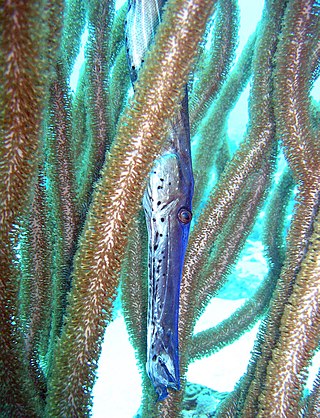
Aulostomus maculatus, the West Atlantic trumpetfish, is a long-bodied fish with an upturned mouth. It often swims vertically while trying to blend with vertical coral, such as sea rods, sea pens, and pipe sponges.

The Urolophidae are a family of rays in the order Myliobatiformes, commonly known as stingarees or round stingrays. This family formerly included the genera Urobatis and Urotrygon of the Americas, which are presently recognized as forming their own family Urotrygonidae. Stingarees are found in the Indo-Pacific region, with the greatest diversity off Australia. They are sluggish, bottom-dwelling fish that have been recorded from shallow waters close to shore to deep waters over the upper continental slope. Measuring between 15 and 80 cm long, these rays have oval to diamond-shaped pectoral fin discs and relatively short tails that terminate in leaf-shaped caudal fins, and may also have small dorsal fins and lateral skin folds. Most are smooth-skinned, and some have ornate dorsal color patterns.

The longtail stingray, is a species of stingray in the family Dasyatidae, found in the eastern Pacific Ocean from Baja California to Colombia. It inhabits sandy habitats down to a depth of 90 m (300 ft). Measuring up to 1.56 m (5.1 ft) across, this species has a rhomboid pectoral fin disc, a lower fin fold on the tail, and numerous dermal denticles along the back and behind the stinging spine. The longtail stingray feeds mainly on bottom-dwelling bony fishes and crustaceans. It is aplacental viviparous, with females giving birth to 1–5 young in late summer. It is caught for food, likely throughout its range, but specific fishery data is lacking.

Kuhl's maskray, also known as the blue-spotted stingray, blue-spotted maskray, or Kuhl's stingray, is a species of stingray of the family Dasyatidae. It was recently changed from Dasyatis kuhlii in 2008 after morphological and molecular analyses showed that it is part of a distinct genus, Neotrygon. The body is rhomboidal and colored green with blue spots. Maximum disk width is estimated 46.5 cm (18.3 in). It is popular in aquaria, but usually not distinguished from the blue-spotted ribbontail ray. The ribbontail has a rounded body, is a brighter green with brighter blue and more vivid spots, but Kuhl's maskray is larger. The stingray's lifespan is estimated at 13 years for females and 10 years for males. The blue-spotted stingray preys on many fish and small mollusks. It is also generally found from Indonesia to Japan, and most of Australia. Kuhl's maskray also is targeted by many parasites, such as tapeworms, flatworms, and flukes.

The spotted eagle ray is a cartilaginous fish of the eagle ray family, Aetobatidae. As traditionally recognized, it is found globally in tropical regions, including the Atlantic, Pacific and Indian Oceans. Recent authorities have restricted it to the Atlantic with other populations recognized as the ocellated eagle ray and Pacific white-spotted eagle ray. Spotted eagle rays are most commonly seen alone, but occasionally swim in groups. They are ovoviviparous, the female retaining the eggs then releasing the young as miniature versions of the parent.

The longnose stingray is a species of stingray in the family Dasyatidae, native to the western Atlantic Ocean from the southern Gulf of Mexico to Brazil. Found in coastal waters no deeper than 36 m (118 ft), this demersal species favors muddy or sandy habitats. The longnose stingray is characterized by its angular, rhomboid pectoral fin disc, moderately projecting snout, and whip-like tail with a dorsal keel and ventral fin fold. It typically grows to 1.25 m (4.1 ft) across and is brownish above and light-colored below.
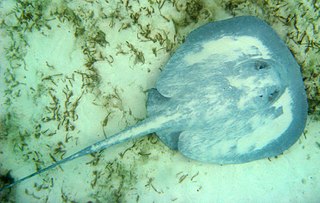
The chupare stingray or Caribbean whiptail stingray is a species of stingray in the family Potamotrygonidae, found in the western Atlantic Ocean from the Gulf of Campeche to Brazil, including the Antilles. The presence of this species in the Gulf of Mexico has not been confirmed. It also occurs in the Bahamas. It usually inhabits sandy substrates, sometimes near coral reefs, and is an infrequent visitor to the Amazon River estuary. Leonard Compagno doubted the taxonomic validity of this species in his 1999 Checklist of Living Elasmobranchs.

The bullseye round stingray, also known as the reticulated round ray, or spot-on-spot round ray, is a species of cartilaginous fish in the family Urotrygonidae. It is endemic to Mexico. Its natural habitats are shallow seas, subtidal aquatic beds, coral reefs, estuarine waters, intertidal marshes, and coastal saline lagoons. It is threatened by habitat loss.
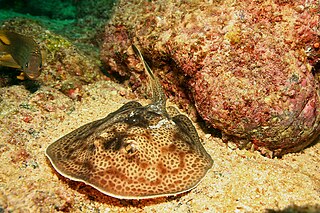
Urobatis is a genus of the family Urotrygonidae. These rays live in Costa Rica, Mexico, the Bahamas, El Salvador, Honduras, Guatemala, Nicaragua, Colombia, Venezuela, Panama, Trinidad and Tobago, Barbados, Grenada, Saint Vincent and the Grenadines, Saint Lucia, Martinique, Dominica, Guadeloupe, Montserrat, Antigua and Barbuda, Belize, Puerto Rico, Saint Kitts and Nevis, Anguilla, Dominican Republic, Haiti, Jamaica, Cuba, Cayman Islands, Virgin Islands, Turks and Caicos Islands, French Guiana, Guyana, Suriname, Chile, Peru, Ecuador and the United States.
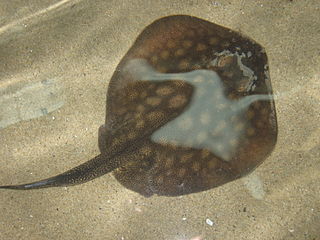
The round stingray or Haller's round ray and Little round stingray is a species of round ray, family Urotrygonidae, found in the coastal waters of the tropical and subtropical parts of the northeastern Pacific Ocean. It is a small, common ray that feeds mostly on benthic invertebrates. On the beaches of southern California, it is responsible for numerous injuries to bathers, who are stung when they accidentally step on the fish. The wound caused by its venomous spine can be painful, but is non-fatal.
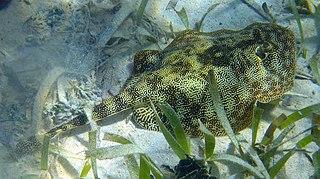
The yellow stingray is a species of stingray in the family Urotrygonidae, found in the tropical western Atlantic Ocean from North Carolina to Trinidad. This bottom-dwelling species inhabits sandy, muddy, or seagrass bottoms in shallow inshore waters, commonly near coral reefs. Reaching no more than 36 cm (14 in) across, the yellow stingray has a round pectoral fin disc and a short tail with a well-developed caudal fin. It has a highly variable but distinctive dorsal color pattern consisting of either light-on-dark or dark-on-light reticulations forming spots and blotches, and can rapidly change the tonality of this coloration to improve its camouflage.

The Tumbes round stingray is a little-known species of round ray, family Urolophidae, known only from two immature male specimens collected from estuarine waters at depths of 1–2 m, and a third specimen collected in 2006 near mangroves. Its range appears to be limited to coastal waters off Tumbes in northern Peru, where it is found partially buried in sand or mud. The larger of the original two specimens measured 40.4 cm long and the smaller 15.7 cm.

The reticulate whipray or honeycomb stingray is a species of stingray in the family Dasyatidae. It inhabits coastal waters in the western Indian Ocean including the Red Sea, Natal and the Arabian Sea; also a Lessepsian transmigrant in the eastern Mediterranean. A large species reaching 2 m (6.6 ft) in width, the reticulate whipray has a diamond-shaped pectoral fin disc and an extremely long tail without fin folds. Both its common and scientific names refer to its ornate dorsal color pattern of many small, close-set dark spots or reticulations on a lighter background. However, the reticulate whipray is only one of several large spotted stingrays in the Indo-Pacific which, coupled with the variability of its coloration with age and locality, has resulted in a great deal of taxonomic confusion.

The smalleye stingray is a large species of stingray in the family Dasyatidae, measuring up to 2.2 m (7.2 ft) across. Rare but widely distributed, it is found in the Indo-Pacific from Mozambique to India to northern Australia. This species may be semi-pelagic in nature, inhabiting both deeper waters and shallow coastal reefs and estuaries. It is characterized by a diamond-shaped pectoral fin disc much wider than long, a tail that is broad and flattened in front of the spine but whip-like behind, and large white spots over its back.

The leopard round stingray or Central American round stingray and Costa Rican round stingray is a small species of round ray found in shallow waters off the coast from Costa Rica to Colombia in the eastern Pacific Ocean.




















